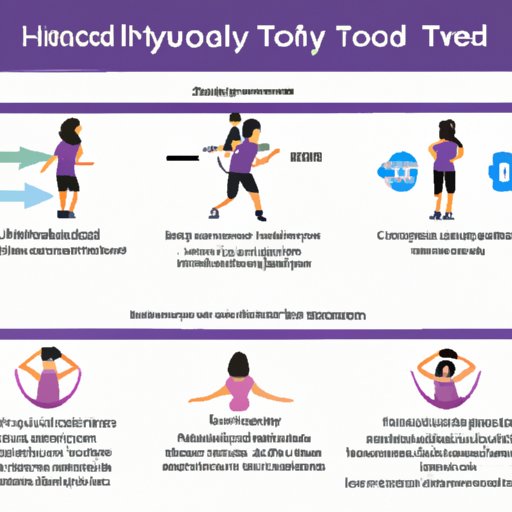Introduction: Overview of Thyroidectomy
A thyroidectomy is a surgical procedure that involves the partial or complete removal of the thyroid gland. The thyroid is an organ located at the base of the neck that produces hormones responsible for regulating the body’s metabolism. In some cases, a thyroidectomy may be necessary due to a variety of health issues such as an overactive thyroid (hyperthyroidism), cancerous growths, or goiters.
The healing process following a thyroidectomy can take anywhere from several weeks to several months, depending on the individual’s overall health. During this time, it is important to prioritize rest, nutrition, and self-care in order to ensure a full recovery. While it is essential to give the body time to heal, regular exercise is also beneficial for aiding in the recovery process and maintaining overall wellbeing.

Outlining the Recovery Timeline for Working Out After a Thyroidectomy
When it comes to resuming physical activity after a thyroidectomy, it is important to follow the advice of your healthcare provider and take into account any additional medical factors that may affect the recovery timeline. Generally speaking, it is recommended to wait at least four to six weeks before beginning any type of exercise program. However, this timeline can vary depending on the individual’s unique situation.
When to Begin Exercising Again
Typically, it is best to wait until the incision site has healed and the stitches have been removed before beginning any type of exercise program. Additionally, if the patient has experienced any complications, such as nerve damage or infection, it is important to wait until these have been addressed by the healthcare team. Once the physician has given approval to begin exercising again, it is important to start slowly with low-impact activities and gradually increase intensity levels over time.
Factors That Influence Recovery Time
In addition to the incision healing, other factors can influence the recovery timeline for returning to exercise after a thyroidectomy. These include the patient’s age, overall health, and pre-surgery fitness level. It is also important to consider the type of thyroidectomy performed and any additional treatments, such as radiation therapy, that may have been required. Depending on the individual’s unique situation, it may take longer than six weeks to return to physical activity.
Tips for Gradually Returning to Physical Activity Post-Thyroidectomy
Once it is safe to begin exercising again, it is important to ease into physical activity gradually in order to avoid injury or overexertion. Here are some tips for gradually returning to physical activity post-thyroidectomy:
Start Slowly and Listen to Your Body
It is important to start slowly when returning to physical activity after a thyroidectomy. Begin with low-impact exercises such as walking, swimming, or yoga and gradually increase the intensity and duration of workouts over time. It is also important to listen to your body and take breaks as needed. If you experience any pain or discomfort, stop immediately and consult with your healthcare provider.
Choose Low-Impact Workouts
Low-impact exercises are ideal for those recovering from a thyroidectomy. These activities put less strain on the body and help to reduce the risk of injury. Examples of low-impact exercises include walking, swimming, cycling, yoga, and Pilates. These types of exercises can help to improve strength, flexibility, and cardiovascular endurance without putting too much strain on the body.
Consider Professional Guidance
Working with a qualified personal trainer or physical therapist can be beneficial for those returning to physical activity after a thyroidectomy. A professional can provide guidance on appropriate exercises and help to create a personalized workout plan that meets the individual’s needs and goals. They can also monitor progress and provide support throughout the recovery process.

Strategies for Exercising Safely After Thyroid Surgery
In order to ensure safety while exercising after a thyroidectomy, it is important to follow certain guidelines. Here are some tips for exercising safely after thyroid surgery:
Warm Up Before Each Session
Before engaging in any type of physical activity, it is important to warm up the body. This helps to increase blood flow, lubricate the joints, and prepare the muscles for movement. Start with light stretching and gradually increase intensity until the body feels warm. This will reduce the risk of injury and help to optimize performance.
Monitor Your Heart Rate
It is important to monitor your heart rate during physical activity. Over-exertion can lead to fatigue, dizziness, and other symptoms. For those recovering from a thyroidectomy, it is advisable to keep the heart rate below 140 beats per minute. This can help to prevent overexertion and ensure safety during exercise.
Avoid High-Risk Activities
High-risk activities such as contact sports and heavy lifting should be avoided during the recovery period. These types of activities can put too much strain on the body, which can delay healing and increase the risk of injury. Additionally, it is important to avoid any exercises that cause pain or discomfort.

The Benefits of Exercise During Recovery from Thyroidectomy
Regular physical activity is beneficial for aiding in the recovery process and maintaining overall wellbeing. Here are some of the benefits of exercise during recovery from thyroidectomy:
Improved Mood and Stress Relief
Exercise can help to boost mood and reduce stress levels. Regular physical activity releases endorphins, which are hormones that act as natural antidepressants and can help to improve mental health. Additionally, exercise can help to reduce tension, improve sleep quality, and promote relaxation.
Increased Strength and Stamina
Physical activity helps to build strength and stamina, which can aid in recovery after a thyroidectomy. Regular exercise can help to strengthen the muscles, improve coordination, and increase energy levels. Additionally, it can help to improve balance and reduce the risk of falls.
Improved Sleep Quality
Exercise can help to improve sleep quality by promoting relaxation and reducing stress levels. Additionally, it can help to regulate hormones and improve overall health, which can contribute to better sleep. It is important to note, however, that exercising too close to bedtime can interfere with sleep.
What to Expect When Returning to Exercise After Thyroid Removal
Returning to physical activity after a thyroidectomy can be challenging. It is important to remember that every individual will experience different levels of discomfort and it is normal to feel tired or sore after exercise. Here are some things to expect when returning to exercise after thyroid removal:
Potential Discomfort
During the recovery process, it is normal to experience some degree of discomfort. This can include soreness, fatigue, and tightness in the neck area. It is important to listen to your body and take frequent breaks to rest and recover. Additionally, it is important to adjust intensity levels as needed to prevent overexertion.
Managing Side Effects
Some individuals may experience side effects such as nausea, dizziness, or shortness of breath after physical activity. If these symptoms occur, it is important to stop immediately and consult with a healthcare provider. Additionally, it is important to stay hydrated and refuel after workouts in order to replenish lost electrolytes.
How to Listen to Your Body and Ease into Exercise After Thyroidectomy
It is important to listen to your body and adjust intensity levels accordingly when returning to physical activity after a thyroidectomy. Here are some tips for listening to your body and easing into exercise after thyroidectomy:
Adjust Intensity Levels
It is important to adjust intensity levels as needed in order to prevent overexertion. Start by focusing on low-impact exercises such as walking or swimming and gradually increase intensity over time. Additionally, it is important to take regular breaks and rest when needed.
Take Regular Breaks
Taking regular breaks is important for allowing the body to rest and recover. Aim to take a break every 10-15 minutes during physical activity. This will help to reduce the risk of injury and ensure safety while exercising.
Monitor Progress
It is important to monitor progress and adjust intensity levels as needed. Keep track of the amount of time spent exercising and the intensity level of each workout. This can help to ensure safety and prevent overexertion.
Conclusion
Returning to physical activity after a thyroidectomy can be challenging, but it is possible with the right approach. It is important to listen to your body and take into consideration any additional medical factors that may affect the recovery timeline. Additionally, it is important to start slowly and gradually increase intensity levels over time. With patience and dedication, it is possible to safely resume physical activity after a thyroidectomy.
(Note: Is this article not meeting your expectations? Do you have knowledge or insights to share? Unlock new opportunities and expand your reach by joining our authors team. Click Registration to join us and share your expertise with our readers.)
